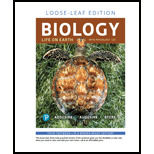
Pearson eText Biology: Life on Earth with Physiology -- Instant Access (Pearson+)
12th Edition
ISBN: 9780135755785
Author: Gerald Audesirk, Teresa Audesirk
Publisher: PEARSON+
expand_more
expand_more
format_list_bulleted
Concept explainers
Question
Chapter 26.8, Problem 1CYL
Summary Introduction
To describe:
The evidences that indicate some human behaviors and learning predispositions are innate.
Introduction:
Behavior is defined as the different types of actions produced by organisms in response to stimuli which is either external or internal. It is responsible for establishing the interaction between individuals of same or other species that provides benefits to each other.
Expert Solution & Answer
Want to see the full answer?
Check out a sample textbook solution
Students have asked these similar questions
What is the structure and function of Eukaryotic cells, including their organelles? How are Eukaryotic cells different than Prokaryotic cells, in terms of evolution which form of the cell might have came first? How do Eukaryotic cells become malignant (cancerous)?
What are the roles of DNA and proteins inside of the cell? What are the building blocks or molecular components of the DNA and proteins? How are proteins produced within the cell? What connection is there between DNA, proteins, and the cell cycle? What is the relationship between DNA, proteins, and Cancer?
Why cells go through various types of cell division and how eukaryotic cells control cell growth through the cell cycle control system?
Chapter 26 Solutions
Pearson eText Biology: Life on Earth with Physiology -- Instant Access (Pearson+)
Ch. 26.1 - Prob. 1TCCh. 26.1 - Prob. 1CYLCh. 26.1 - Prob. 2CYLCh. 26.1 - Prob. 3CYLCh. 26.2 - Prob. 1CYLCh. 26.2 - Prob. 2CYLCh. 26.3 - Prob. 1CYLCh. 26.3 - Prob. 2CYLCh. 26.3 - Prob. 3CYLCh. 26.4 - Does symmetry have a scent? In one study,...
Ch. 26.4 - compare the advantages and disadvantages of...Ch. 26.4 - Prob. 2CYLCh. 26.5 - Prob. 1TCCh. 26.5 - Prob. 2TCCh. 26.5 - Prob. 1CYLCh. 26.5 - Prob. 2CYLCh. 26.6 - Prob. 1CYLCh. 26.6 - Prob. 2CYLCh. 26.7 - list the advantages and disadvantages of living in...Ch. 26.7 - Prob. 2CYLCh. 26.8 - Prob. 1HYEWCh. 26.8 - Prob. 1CYLCh. 26.8 - Prob. 2CYLCh. 26.8 - Prob. 3CYLCh. 26.8 - Is our perception of human beauty determined by...Ch. 26 - Prob. 1MCCh. 26 - The benefits to an individual of living in a...Ch. 26 - Prob. 3MCCh. 26 - Prob. 4MCCh. 26 - Prob. 5MCCh. 26 - Prob. 1FIBCh. 26 - Prob. 2FIBCh. 26 - Prob. 3FIBCh. 26 - Prob. 4FIBCh. 26 - Prob. 5FIBCh. 26 - Prob. 6FIBCh. 26 - Prob. 1RQCh. 26 - Prob. 2RQCh. 26 - Prob. 3RQCh. 26 - Prob. 4RQCh. 26 - Discuss the advantages and disadvantages of group...Ch. 26 - Prob. 6RQCh. 26 - Prob. 1ACCh. 26 - Prob. 2ACCh. 26 - Prob. 3AC
Knowledge Booster
Learn more about
Need a deep-dive on the concept behind this application? Look no further. Learn more about this topic, biology and related others by exploring similar questions and additional content below.Similar questions
- In one paragraph show how atoms and they're structure are related to the structure of dna and proteins. Talk about what atoms are. what they're made of, why chemical bonding is important to DNA?arrow_forwardWhat are the structure and properties of atoms and chemical bonds (especially how they relate to DNA and proteins).arrow_forwardThe Sentinel Cell: Nature’s Answer to Cancer?arrow_forward
- Molecular Biology Question You are working to characterize a novel protein in mice. Analysis shows that high levels of the primary transcript that codes for this protein are found in tissue from the brain, muscle, liver, and pancreas. However, an antibody that recognizes the C-terminal portion of the protein indicates that the protein is present in brain, muscle, and liver, but not in the pancreas. What is the most likely explanation for this result?arrow_forwardMolecular Biology Explain/discuss how “slow stop” and “quick/fast stop” mutants wereused to identify different protein involved in DNA replication in E. coli.arrow_forwardMolecular Biology Question A gene that codes for a protein was removed from a eukaryotic cell and inserted into a prokaryotic cell. Although the gene was successfully transcribed and translated, it produced a different protein than it produced in the eukaryotic cell. What is the most likely explanation?arrow_forward
- Molecular Biology LIST three characteristics of origins of replicationarrow_forwardMolecular Biology Question Please help. Thank you For E coli DNA polymerase III, give the structure and function of the b-clamp sub-complex. Describe how the structure of this sub-complex is important for it’s function.arrow_forwardMolecular Biology LIST three characteristics of DNA Polymerasesarrow_forward
arrow_back_ios
SEE MORE QUESTIONS
arrow_forward_ios
Recommended textbooks for you
 Biology (MindTap Course List)BiologyISBN:9781337392938Author:Eldra Solomon, Charles Martin, Diana W. Martin, Linda R. BergPublisher:Cengage Learning
Biology (MindTap Course List)BiologyISBN:9781337392938Author:Eldra Solomon, Charles Martin, Diana W. Martin, Linda R. BergPublisher:Cengage Learning Human Heredity: Principles and Issues (MindTap Co...BiologyISBN:9781305251052Author:Michael CummingsPublisher:Cengage Learning
Human Heredity: Principles and Issues (MindTap Co...BiologyISBN:9781305251052Author:Michael CummingsPublisher:Cengage Learning Issues and Ethics in the Helping Professions (Min...NursingISBN:9781337406291Author:Gerald Corey, Marianne Schneider Corey, Cindy CoreyPublisher:Cengage Learning
Issues and Ethics in the Helping Professions (Min...NursingISBN:9781337406291Author:Gerald Corey, Marianne Schneider Corey, Cindy CoreyPublisher:Cengage Learning Biology: The Dynamic Science (MindTap Course List)BiologyISBN:9781305389892Author:Peter J. Russell, Paul E. Hertz, Beverly McMillanPublisher:Cengage Learning
Biology: The Dynamic Science (MindTap Course List)BiologyISBN:9781305389892Author:Peter J. Russell, Paul E. Hertz, Beverly McMillanPublisher:Cengage Learning Principles Of Radiographic Imaging: An Art And A ...Health & NutritionISBN:9781337711067Author:Richard R. Carlton, Arlene M. Adler, Vesna BalacPublisher:Cengage Learning
Principles Of Radiographic Imaging: An Art And A ...Health & NutritionISBN:9781337711067Author:Richard R. Carlton, Arlene M. Adler, Vesna BalacPublisher:Cengage Learning

Biology (MindTap Course List)
Biology
ISBN:9781337392938
Author:Eldra Solomon, Charles Martin, Diana W. Martin, Linda R. Berg
Publisher:Cengage Learning

Human Heredity: Principles and Issues (MindTap Co...
Biology
ISBN:9781305251052
Author:Michael Cummings
Publisher:Cengage Learning


Issues and Ethics in the Helping Professions (Min...
Nursing
ISBN:9781337406291
Author:Gerald Corey, Marianne Schneider Corey, Cindy Corey
Publisher:Cengage Learning

Biology: The Dynamic Science (MindTap Course List)
Biology
ISBN:9781305389892
Author:Peter J. Russell, Paul E. Hertz, Beverly McMillan
Publisher:Cengage Learning

Principles Of Radiographic Imaging: An Art And A ...
Health & Nutrition
ISBN:9781337711067
Author:Richard R. Carlton, Arlene M. Adler, Vesna Balac
Publisher:Cengage Learning